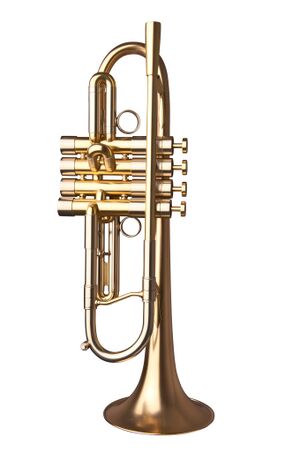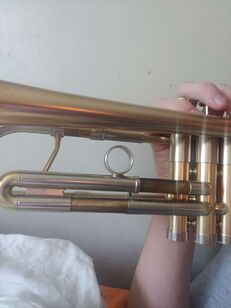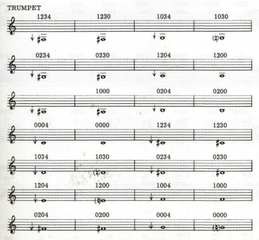Trumpet
The trumpet is a harmonically tuned instrument typically designed to play music written in 12edo. In a standard trumpet, this is achieved by a root pitch within the harmonic series, and three valves, which respectively lower the pitch by either two semitones, one semitone, or three semitones. By combining the three valves, the trumpet can semi-accurately play notes in 12edo (with a basis of a certain just intonation due to its reliance on the harmonic series).
Certain notes (especially notably, the written low C# or Db) have poor tuning due to this design and must be adjusted with a trumpet's adjustable valve tuning slides. For most trumpets, all three valves can be retuned; the first and third can be retuned in real time.
While the trumpet is generally designed for 12edo, there are several ways to play in other tuning systems – by custom trumpets (generally quartertone trumpets), non-standard fingerings, adjusting tuning slides, or by pitch bending via embouchure.
Intonation
This section is largely taken from the article Intonation of the valve trumpet by Joseph Monzo.
As noted in the opening section, trumpets are justly tuned. A trumpet is based on the harmonic series, and each valve of the trumpet lowers the pitch. Later in this article, in the retuning section, valves are described to lower the pitch of the instrument in clean cent values (i.e. 100c, 200c, 300c). This works for a general basis of understanding retuning; however, valve tubing lengths are also tuned on a just intonation basis. In general, the first valve tubing is 1/8th the length of the main slide, the second 1/15th, the third 1/5th. (For four-valve trumpets: if it is a quartertone trumpet, the fourth valve is usually 1/30th of the main slide; if it is an extended range trumpet, the fourth valve is usually 13/40th.)
In the article, Monzo explains that combining valves will change these ratios to more complex values. In summary, the combinations themselves:
| Valves | ΔLength | Frequency Ratio |
Cents |
|---|---|---|---|
| 2 | +1/15 | 15/16 | -112 |
| 1 | +1/8 | 8/9 | -204 |
| 12 | +23/120 | 120/143 | -304 |
| 3 | +1/5 | 5/6 | -316 |
| 23 | +4/15 | 15/19 | -409 |
| 13 | +13/40 | 40/53 | -487 |
| 123 | +47/120 | 120/167 | -572 |
Observe that as valve combinations grow, the pitch sharpens from its target more and more (i.e. the valve combination 123 should target -600c but ends up 28 cents sharp). This is why, for large combinations like 13 and 123, it's advised in 12edo tuning to kick your third valve slide to accommodate this sharpening effect.
Custom trumpets and quartertone trumpets
There is a relatively short history of trumpets designed for the purpose of playing in extended tuning systems. The most popular microtonal trumpets are quartertone trumpets, which have a history of use in jazz and maqam.
History in popular music

Don Ellis was a big band jazz musician and trumpeter. He was one of the first to use quartertone trumpets, which was created by Holton. The trumpet used four standard button valves; the first three unchanged, and an additional fourth valve used to lower the pitch by a quartertone (the smallest interval in 24edo). Ellis was active through the 1960s and early 1970s until his death. His music is normally designed for 12edo, but he often employed microtonality in his improvised solos.
Ibrahim Maalouf is an active French-Lebanese jazz musician and trumpeter known for combining Middle Eastern folk with modern jazz music. His father, Nassim Maalouf, is credited with inventing a quartertone trumpet, which both he and Maalouf used. Ibrahim often uses his quartertone trumpet to play Arabic maqams in his jazz music.
Commercial quartertone trumpets
Professional trumpet technicians have historically created rotary valves which attach to the main tuning slide that lower the pitch of the trumpet by a quartertone.
While uncommon, there are also quartertone trumpets available for purchase or commission:
The Adams A4 is a jazz trumpet which can be ordered to include a quartertone valve. Other Adams trumpets sometimes include a quartertone option.
CarolBrass also creates commercial quartertone trumpets, namely the CTR-5000H4V-YLT(D)-SL.
Ibrahim Maalouf partnered with AJ Atelier des Cuivres to commercially sell the "TOMA trumpet," a quartertone trumpet which Maalouf now uses exclusively.
Pujé trumpets are built with directly adjustable slides on the main tuning slide. According to Brent Peters, however, the slide is "hard to use accurately and quickly enough" [to play quartertones], "even with a trigger."
Van Laar is known to have created quartertone trumpets.
In 2018, Monette shared a post about their "first ever custom quarter-tone trumpet."
Other
Vasilis Nalbantis created a xenharmonic trumpet, the "Nalbantis," designed to play maqams. Unlike other trumpets listed, the additional button is pressure-sensitive, allowing for more pitches, but less pitch accuracy, when playing the trumpet. The button changes the length of the tuning slide.
Stephen Altoft and Donald Bousted created a trumpet project titled "The Microtonal Trumpet," creating microtonal trumpets using rotary valves which can play in 19edo, 24edo, and 48edo.
Other methods of xenharmonic playing
A custom trumpet is the best and easiest way to play xenharmonic music; however, it certainly isn't always a practical option.
Quartertones
Alternative fingerings
Quartertones for most notes can be approximated well with alternative fingerings and the use of the third valve slide.
Refer to the fingering chart (starting at middle G and ascending):
| Note | G | vG# | G# | vA | A | vA# | A# | vB | B | vC | C | vC# | C# | vD | D | vD# | D# | vE | E | vF | F | vF# | F# | vG | G |
|---|---|---|---|---|---|---|---|---|---|---|---|---|---|---|---|---|---|---|---|---|---|---|---|---|---|
| Fingering | 0 | 23 (S) | 23 | 3 (S) | 12 | 123 (S) | 1 | 13 (S) | 2 | 23 (S) | 0 | 3 (S) | 12 | 13 (S) | 1 | 23 (S) | 2 | 3 (S) | 0 | 13 (S) | 1 | 123 (S) or 23 (S) |
2 | 13 (S) or 3 (S) |
0 |
The (S) signifies that use of the third valve slide is necessary.
General xenharmonic music

Retuning valves
On most trumpets, you can play edos with fewer divisions than 12edo by retuning each valve slide individually. Because each valve's tubing is adjustable, you can lengthen them to lower the pitch by the number of cents corresponding to the semitones targeted by the valve. This method can be done similarly on quartertone trumpets; however, usually, the quartertone valve tubing (50 cents) cannot be adjusted.
For instance, 10edo's semitone is 120 cents; to retune a standard trumpet from 12edo to 10edo, you could adjust the first valve (two semitones) from 200 cents to 240, the second valve (one semitone) from 100 cents to 120, and the third valve (three semitones) from 300 cents to 360. (Note that this description of valve intonation is limited; see the Intonation section for a more detailed description).
Keep in mind that this retuning method grows less accurate in the lower register, because trumpets are built on the harmonic series. Tuning systems with, for instance, a poor 3/2 (fifth), will now have a perfect 3/2 when played on the trumpet; similarly, notes between low C and middle G will be offsets of that perfect 3/2. This creates a sort of limited, quasi-just intonation sound (as brass instruments already are). You can fix this in real-time by adjusting your embouchure, "lipping" the notes.
Alternative fingerings
There are several fingering combinations for the trumpet that are not traditionally used simply because they do not approximate any pitch in 12edo. These notes can be used as a very limited set of additional pitches for xenharmonic music. These have limited functionality, but can be seen featured in small works, such as on Oli Parker's YouTube video, The Xenharmonic Trumpet.
Lipping
A common way to bend pitches on trumpet is to "lip" the note - effectively moving your embouchure to crudely target a pitch other than the speed of air and tubing length would otherwise allow. This method can be used to play xenharmonic music and is often used in conjunction with other methods of playing xenharmonic music.
Notation

Like any other instrument, xenharmonic notation doesn't need to deviate far beyond the existing standards. However, with the trumpet in particular, there has been some discourse on specific types of notation which would allow for sight-reading quartertonal music, due to the implementation of a single button which "enables" quartertones.
Most notably, Don Ellis created a notation system designed for quartertone trumpet using standard notation and downward arrows. In his book, Quarter Tones: A Text with Musical Examples, Exercises and Etudes, he wrote:
"On the four valve quarter-tone trumpet the first three valves operate exactly like the normal three valve trumpet. The fourth valve lowers any combination of the first three by a quarter of a tone. Because this is the way the trumpet operates, I have found it expedient to always indicate quarter tones for the trumpet with the arrow downward. This means the trumpeter has only to play whatever note [they see], whether natural, sharped or flatted, and if the arrow points downward in front of it [they] merely [depress] the fourth valve to get the proper tone."
This notation system could be quickly adapted to most other common tunings for the trumpet. For 24edo, the notation system can be referred to as "Don Ellis notation" or "Ellis notation."
For the Nalbantis trumpet, Vasilis created a simple notation system for 48 divisions, which can be seen in his piece, Χερουβικός Ύμνος.
Music
Note: This is not a comprehensive list for many of the artists listed.
- Stephen Altoft
- Time Dreaming (19edo)
- Four Aspects
- Gathering Meaning (19edo)
- Don Ellis
- Old Man's Tear (24edo)
- Sladka Pitka (24edo)
- Indian Lady (24edo)
- Trumpet Extensions with Andy Kozar / Microtonality (2022) (instructional video, with demonstration of use of valve slides and lipping to get microtones even on a trumpet only having 3 valves)
- look (34edo with 17edo trumpet)
- Ibrahim Maalouf
- Questions and Answers (24edo)
- Beirut (24edo)
- Feeling Good (feat. Dear Silas) (24edo)
- Nassim Maalouf
- Walid Gholmieh (24edo)
- Vasilis Nalbantis
- Χερουβικός Ύμνος (48-tone unequal tuning)
- Βασίλης Ναλμπάντης (48-tone unequal tuning)
- Τεριρέμ (48-tone unequal tuning)
- Oli Parker
External links
- The Microtonal Trumpet, by Stephen Altoft, Donald Bousted — extended techniques, 19edo trumpet
- The Microtonal Trumpet (2007-2016, archived)
- The Microtonal Trumpet on Microtonal Projects' BLOG (2017-2022, archived)
- Double Bell Trumpet (2007-2014, archived), by Marco Blaauw — quartertone (24edo) trumpet
- Microtones on The Modern Trumpet, by Nathan Plante — extended techniques, quartertone (24edo) trumpet
- Intonation of the valve trumpet, by Joseph L. Monzo (2003)